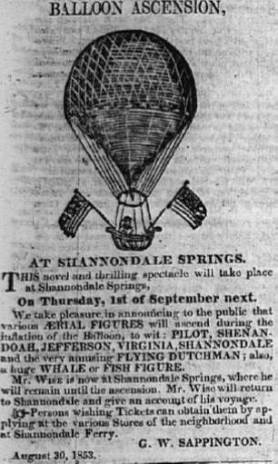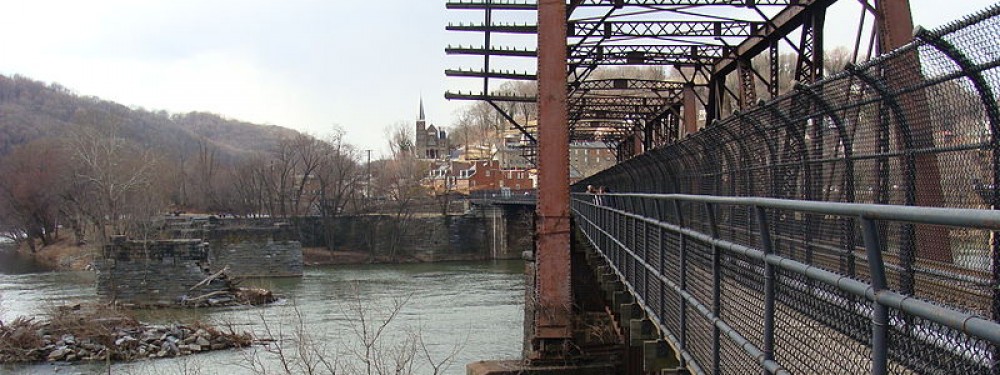In antebellum Jefferson County, the months of July through September were known as the “sickly season,” when diseases like cholera, dysentery, and scarlet fever were most prevalent. The causes and cures for these ailments were not discovered until after the Civil War, but many city dwellers believed such scourges could be avoided by imbibing the mineral waters available at the Shannondale Springs resort in Jefferson County, Virginia.
The summer of 1853 was worse than usual, and attendance at Shannondale Springs soared. For many who resided there for the season, the Springs social amenities were just as important as its medicinal benefits. Hunting and fishing, musical performances, and fancy dress balls were just a few of the distractions available for those who came to take the cure. That summer they were to be treated to something special — a balloon ascension by “Mr. JOHN WISE, one among the greatest aeronauts that any
country has yet furnished….”

This time the advertising copywriter was not exaggerating, for John Wise was truly recognized as the premier balloonist in the United States at the time.
Born in Lancaster, Pennsylvania, in 1808 to a working class family, John Wise became interested in ballooning as a teenager, and constructed his first balloon at age 27. Ballooning was an expensive and dangerous profession, and Wise financed his passion by performing at county fairs and special events, such as the one scheduled for Shannondale Springs.
More than just an entertainer, Wise used these events to conduct scientific experiments on balloon flight. In 1838, he developed a balloon that functioned as parachute if punctured, and his design saved his life the same year when the balloon he was flying ruptured at 13,000 feet. Wise also pioneered the use of a drag line to stabilize the balloon in flight and the use of a rip panel to release gas.
In the summer of 1853, Wise was accumulating the money and experience needed for his most spectacular project. The Spirit of Jefferson noted that he “… contemplates a voyage across the Atlantic Ocean in a Balloon, and should his efforts at Shannondale Springs, on the latter part of this month be crowned with success, who can say that he will not receive from the county of Jefferson, the necessary impetus to enable him to triumph over all his former difficulties. He has made 159 ascensions, and we feel very confident his ascension from Shannondale may now be set down at the 160th.”
The date for the flight from Shannondale was set for September 1, and Wise spent much of August in Baltimore, where he constructed a balloon ” of the largest class, containing upwards of five hundred yards of silk.” His 17-year-old son, Charles, had been born into ballooning and assisted his father at many of these events. For the Shannondale flight, John Wise had planned to follow standard procedure, which was to ascend with one or more prominent companions amidst flags and fanfare, release the tether that anchored
them to the ground, drift off a few miles, and descend. Then he would return to the launch site and regale spectators with his exploits.
But on this particular day his plans changed, for he let his son make his first solo balloon flight. Charlie’s account (page 2, column 2) of his voyage appeared in the next issues of the Spirit of Jefferson and Virginia Free Press along with his father’s reason for his decision:
To the Editor of the Spirit of Jefferson:
Having made arrangements with Capt. G.W. SAPPINGTON, to make a Balloon ascension from the Springs on the 1st day of Sept., it was generally understood that I would ascend myself, and such was originally my intention; but my son CHARLES, aged 17 years last June, who has accompanied me three different times on aerial excursions,
being very solicitous to make the voyage by himself, and the day being very calm, I gave
him the Balloon and started him off alone.
He made a beautiful ascent — satisfactory to every person assembled at Shannondale,
and he gives you the history of his voyage in his own words. I would embrace this favorable opportunity of saying that I have been pleased — nay delighted, with every living soul I came in contact with since sojourning at the Springs, and in all my dealings with Capt. G.W. Sappington, proprietor of Shannondale, I found him a gentleman of the true Virginia stamp. He provided for the occasion on a liberal and expensive scale — determined to make every one comfortable and happy within the circle of his sphere, to the fact of which a host of visiters will bear honorable testimony, and will, I am satisfied, with myself, always recur to Shannondale with pleasant emotions.
JOHN WISE.
John Wise’s plans for transatlantic flight crashed in 1857 along with the balloon he was building. However, in August 1859 he made the first airmail delivery in the U.S. from Lafayette, Indiana to Crawfordsville, Indiana. Both John and Charles Wise joined the balloon corps during the Civil War, where the father explored uses of balloons for map making and aerial surveillance. John Wise’s career came to a dramatic end on September 28, 1879, when the balloon he was manning disappeared in high winds over Lake Michigan. The body of his companion, George Burr, was recovered, but John Wise and his balloon were never seen again.
You can follow Charles Wise’s balloon journey in S. Howell Brown’s 1852 map of Jefferson County, available at The West Virginia GeoExplorer Project main website. Ehud Turner’s property is located in the upper right portion of the map. Original sources and photographs related to Shannondale Springs can be viewed by searching the database on the same website.
(This post is a shortened version of an article written by Dr. William Theriault)

